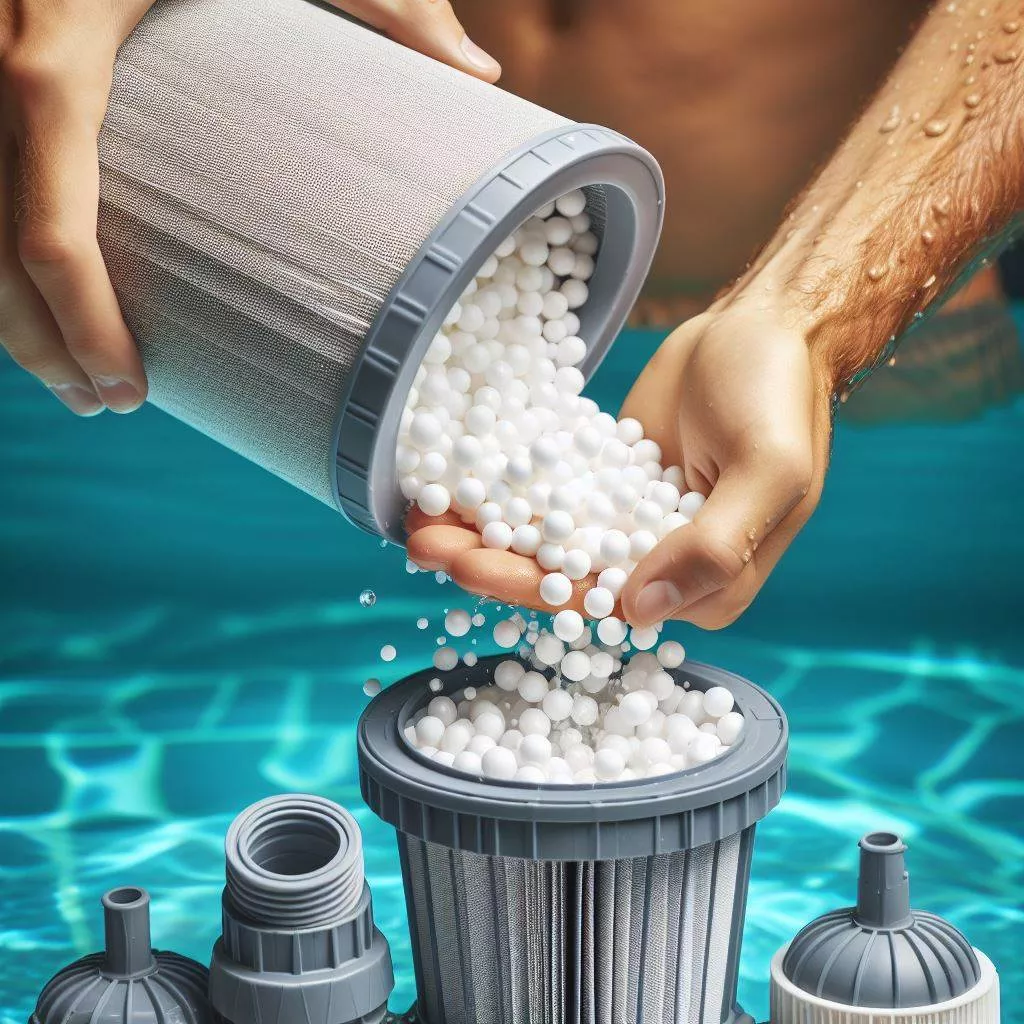Summer is here, and swimming pools have become a great place to cool off. However, maintaining clear and clean pool water is a challenge for many pool owners. Today, we will explore how to use pool filter balls in a sand filter for the first time, ensuring your pool water remains in top condition.
What Are Pool Filter Balls?
Before diving into the usage methods, let’s understand what pool filter balls are. Pool filter media balls are a new type of filter media, typically made from high-density fiber materials. Compared to traditional sand, they offer several advantages, including being lightweight, having better filtration efficiency, and being easy to clean and replace.
Working Principle of Pool Filter Balls
Pool filter balls capture tiny particles and impurities in the water through their dense fiber structure. These fibers can absorb particles smaller than those caught by traditional sand, thus maintaining cleaner water more effectively. Additionally, the design of filter balls ensures that water flows through them without causing blockages, maintaining smooth water flow.
Advantages of Pool Filter Balls
Better Filtration Efficiency
Compared to traditional sand, filter balls vs sand, filter balls provide better filtration efficiency. They can capture finer particles, making the pool water clearer.
Easy Operation
Pool filter balls are lightweight, making them easy to install and replace. In contrast, traditional filter sand requires more labor and time.
Easy to Clean and Maintain
Filter balls can be easily removed from the filter and rinsed clean with water. In contrast, cleaning and maintaining sand is much more complicated.
How to Use Pool Filter Balls in a Sand Filter for the First Time
Step 1: Preparation
Before starting, make sure you have turned off the pool filtration system and prepared all necessary tools and materials. The main tools you need include a bucket, a hose, and some cleaning tools.
Step 2: Empty the Old Filter Media
Open the top cover of the filter and remove all the old filter sand. This step may take some time and effort, but it is necessary to ensure the new filter balls work effectively.
Step 3: Clean the Filter
After emptying the old filter media, thoroughly clean the inside of the filter with clean water to ensure there are no residual sand particles or other impurities. After cleaning, make sure the filter is dry and free of water.
Step 4: Fill with Filter Balls
Determine the number of filter balls needed based on the size of the filter. A common rule of thumb is that 1 kilogram of filter balls can replace 75 kilograms of filter sand. Calculate the required amount of filter balls for sand filter accordingly, and then evenly pour the appropriate amount of filter balls into the filter, ensuring it is filled to the proper height.
Step 5: Restart the Filtration System
After filling with filter balls, close the filter cover and start the pool filtration system. Observe the water flow to ensure there are no leaks or other abnormalities. The filter balls should work normally and begin filtering the pool water.
Solving Pool Water Quality Issues
After using pool filter balls, you may notice a significant improvement in pool water quality. However, some common issues may still occur, and here are some solutions.
Cloudy Water
Even with high-efficiency filter balls, cloudy water may still be a problem. To solve this, increase the filtration time to ensure the system can work sufficiently. Additionally, regular cleaning of the filter balls is important to maintain their filtration efficiency.
Odor in the Water
If you notice an odor in the water, consider increasing the circulation time and ensuring the proper balance of chemicals in the water. Adding appropriate pool cleaners can also help remove the odor.
Reduced Filtration Efficiency
If you notice a decrease in filtration efficiency, the filter balls may need cleaning or replacing. Regularly check the condition of the filter balls and maintain them as needed.
Maintenance and Replacement of Filter Balls
While maintaining filter balls is relatively simple, it still needs to be done regularly to ensure optimal filtration efficiency.
Cleaning Filter Balls
After a period of use, filter balls will accumulate some impurities, affecting their filtration efficiency. Every few months, remove the filter balls from the filter and rinse them clean with water to remove attached impurities.
Replacing Filter Balls
Although filter balls have a long lifespan, they are not permanent. Generally, the lifespan of filter balls is 2-3 years. When you notice a significant decrease in their filtration efficiency or cannot restore it through cleaning, it is time to replace them with new filter balls.
Frequently Asked Questions
How to Determine the Number of Filter Balls Needed?
The number of filter balls for sand filter needed depends on the weight of the filter sand originally used. One kilogram of filter balls can replace 75 kilograms of filter sand, so calculate accordingly.
Can Filter Balls Solve All Water Quality Issues?
While filter balls offer high filtration efficiency, they cannot solve all water quality issues. Problems such as chemical contamination and algae growth still need to be addressed through other methods.
How Often Should Filter Balls Be Cleaned?
Based on usage frequency and pool water conditions, it is generally recommended to clean filter balls every 2-3 months to maintain their optimal filtration efficiency.
Through this introduction, we hope you have gained a deeper understanding of pool filter media balls. As a new type of pool filter media, filter balls offer many advantages over traditional filter sand. Proper use and maintenance of filter balls can effectively enhance pool water quality. If you have any other questions while using filter balls, feel free to leave a comment, and we will do our best to answer them. We hope this article helps you maintain clear and clean pool water.


 Instant
Quote
Instant
Quote Email
Us
Email
Us